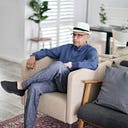Unveiling Contrasts
An experience in wilful disruption
Stepping out of your comfort zone and trying new things shows healthy growth — a change that brings energy. This idea struck me as I embraced a wilful disruption to my otherwise first-world view during a recent trip to my old country, Sri Lanka.
I stayed in a huge bungalow in Colombo’s fanciest neighbourhood, where black metal gates surrounded multi-story dwellings, separating walled gardens from the commoners. Staying there felt like staying in a five-star hotel, with helpful housekeepers and butlers taking care of everything and skilled chefs preparing meals. The garages housed a fleet of limousines, while at the mere flick of a call, half a dozen drivers sprang into action. Security guards were always around, helped by cameras watching everything.
While living in this sheltered space, I saw the chaotic traffic on the nearby roads. Buses drove recklessly, disregarding road users’ safety. They ignored the pedestrian crossings and lane markers. They honked loudly all the time.
It was interesting because wealthy and famous people live in this luxurious area. Even the President’s private home was close by. Imagine! How might things be in the city's poorer parts, the suburbs and regional areas?
In a unique blend of differences, I willingly forced change into my experiences, wishing to discover new things.
Buses made me curious. I chose to embark on a bus journey, disrupting my comfort. I boarded a bus, knowing I was in unchartered territory. The boarding process involved climbing three steps to the bus’s platform level. Before I could climb the steps through the entry without doors, the bus started moving. It forced me to balance myself and create a passenger safety concern. It occurred to me that such occurrences are commonplace for the everyday populace of Sri Lanka.
It took me a while to master the art of balancing myself in a bus that braked and sped like it was driving through a danger zone. The bus raced with other buses, often blocking other buses at bus halts. I felt like an acrobat when I was forced to balance myself.
After a few minutes, I found an unoccupied seat a few rows from the entrance. Sitting as I would on Sydney buses, I encountered the metal handle at the back of the seat that hit my bum. It dawned on me that the seating arrangement provided minimal leg space. The windows rattled, and the bus engine roared like a lorry with a piece of human cargo, me. The chassis used for trucks is also the basis for the construction of commuter buses.
Standing at 5' 9", I don’t particularly tower over others, yet these bus seats accommodated those of shorter stature. The intention appeared to maximise passenger capacity within the bus, consequently offering little leeway for the comfort of commuters.
The bus conductor moved effortlessly through the bus, going from seat to seat to collect cash from passengers, approaching them with a swagger down the aisle. He had a wad of notes stuck between his fingers. His appearance was dishevelled, with unkempt hair and bare feet. His teeth and lips were stained red from the betel he had been chewing, and he rhythmically shifted his jaw from left to right as he chewed the substance stuck in his mouth. He gave me an odd look when he reached me, possibly due to my Sinhala accent that harked back to my school days in the seventies in Sri Lanka. Accustomed to Apple Pay from my iWatch and unfamiliar with cash, with difficulty, I paid him a blue note from my bundle of much-soiled Lankan Rupees. While I found the conductor strange, he, too, found me strange. That was weird, indeed.
As my stop approached, heading towards the front of the bus towards the exit, I observed the driver in action. He navigated with one hand on the steering wheel, habitually honking every twenty seconds as though it was a compulsion he couldn’t shake. With his left hand gripping the gear shift, he drove barefoot. He pressed the pedals down with his feet, speeding up and slowing down erratically. Hanging by his side was a brick phone suspended by a rope. While driving aggressively, he took a call on the mobile phone and shouted at someone in Sinhala. He was a master of multitasking, unlike anything I had witnessed. Passenger safety was not in his vocabulary.
A vibrant array of images of colourful deities adorned the space above the driver. The deities formed a striking row. Surrounding these images, rows of miniature lights glowed with various hues. This display hinted at the driver’s intense devotion and affection for his Gods. However, his reverence seemed reserved solely for his divine beliefs, as it didn’t translate into care for the passengers or fellow road users.
Finally alighting from the bus, I was relieved to be off it.
Where I live, the public transportation networks offer highly effective mobility solutions through various modes such as buses, trains, autonomous trains, light rail, ferries, and electric bicycles. This creates a dynamic and accessible mobility ecosystem that caters to the community's and passengers' diverse needs. However, my experience with the public transportation experiment in Sri Lanka was a stark contrast, leaving me unsettled and uncomfortable in this unfamiliar world.
These contrasts disturbed my mind unexpectedly, leaving me with an unease I hadn’t anticipated. It was an out-of-this-world mind-bender.
Subscribe to my stories https://djayasi.medium.com/subscribe.
Images belong to the original owners.
Part II of this story — A train ride
